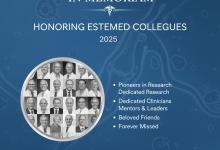Best of 2020: Some Good Things, During the Time of COVID-19 Save
Editor's note: This blog originally appeared April 1, 2020 and is being shared again as a "Best of 2020" wrap up this year.
It is not hyperbole to acknowledge that the COVID-19 pandemic has changed the world, inflicting pain and suffering to many, and inconvenience to all. As everyone struggles to make it through these difficult times, it might be worth pointing out some small silver linings that have emerged despite this pernicious dark cloud.
At a recent clinic, before video-visits were working smoothly, my schedule had shrunk to just 3 new patients, spread across the 4 hour session. Initially I was disappointed, all the more so after reviewing their charts and realizing that 2 of them almost certainly did not have any rheumatologic condition.
But the patients had traveled a good distance and made the effort to show up in person – no small thing these days. So I determined to try to make the best of it. I talked to the patients at great length, and reviewed in detail the confusing assortment of old notes and outside data that was meant to serve as old records. Then we talked more, and reviewed more, and chatted more… the visits all went on for over an hour.
Although I dutifully documented every single thing in EPIC, I also did something I don’t have the time to do much these days: push away the keyboard and look at the patient when talking to them.
At the end, I tried to offer my best judgement about their complex cases, and my advice for how to move forward. The patients were all extremely appreciative, even those without a rheumatologic explanation for their case. After the clinic, I experienced some sensations that seem to have become less common after clinic – happiness and satisfaction.
In an era of increasing prevalence of physician burnout, I remembered why it is a privilege to be a doctor. I realized that it was not the “ANA 1:40, diffuse symptoms” consult per se that stressed me, it was a system where I was a drone to the schedule and the electronic record, and these were making it harder to be the kind of doctor we all want to be.
I will try to remember this as things return to normal.
One of the stressful aspects of current medical practice is dealing with the myriad messages that EMR systems facilitate. I think all of us have something similar to what I call the “AK ratio” (> 2 MyChart messages per each actual office can be used to classify a patient with fibromyalgia). With the recent pandemic, and its potential impact on our immunosuppressed patients, as well as the higher profile of some of our rheumatologic medications, all of our InBoxes have overflowed with MyChart messages.
But it seems as the tone of the MyChart messages is different. The majority of messages begin with or include something like “Doctor; I hope you and your family are well..” in addition to the medical question. And the medical question is usually important and difficult, even if there is not a clear answer. It seems that this was the way the message system was supposed to be.
Maybe the crisis has brought out the humanity in people. Maybe the messages we get come more from people who don’t typically write MyChart messages. A patient this morning wrote to ask if she should stop taking her hydroxychloroquine because she had read that supplies were low, and others might benefit from it more than she! So I shudder far less when about to click on my InBox than I did before the pandemic, and just hope it stays this way, at least for a while.
For those who have had to go into the hospital, things are certainly different. From being assessed at entry, to the reminders everywhere about the need for protection, to the reduced numbers of people on the wards, it all has a different feel. Despite the ‘hunkered down’ aspects, something else that is different than most other days is that people are nicer to each other. Almost everyone makes eye contact, and offers well wishes that are genuine. It is almost like rounding on the wards on Christmas Day, when everyone in the hospital seems to be in a better mood. But in this case it is not celebratory, but more from a sense of shared humanity.
Video visits in rheumatology have gone from being uncommon to becoming standard, almost overnight it seems. Being a Luddite, I resisted a bit at first. How could a discipline so grounded in physical exam be of any value on a video visit? And the fact that most patients at first seemed to prepare for filming their video visits by watching and emulating the movie “Blair Witch” did not help!
But even I am coming around to the idea that video visits do seem to have a place in rheumatology. I did one of my first New Patient visits on video last week, with some trepidation. However, the question was focused, and with a thorough review of systems, recording patient reported outcomes (PROs) and by reviewing the available laboratory and imaging data with the patient, the visit was as successful as it would have been in person.
I think video visits are here to stay. As Dr Alvin Wells points out, as manpower issues becoming increasingly important to all of us, video visits may be a way for all of us to share our expertise and better serve the patients who need us.
I hope everyone is safe and doing well in this difficult time. We will all emerge, and perhaps in some ways will have learned to appreciate some good things, despite the challenges.
Join The Discussion
Well said and timely. Thanks, Artie.








If you are a health practitioner, you may Login/Register to comment.
Due to the nature of these comment forums, only health practitioners are allowed to comment at this time.